The University of Massachusetts Engineering Center for Collaborative Adaptive Sensing of the Atmosphere is partnering with companies to give the National Aeronautics and Space Administration an unmanned aircraft flight demonstration in 2020.
The project is one of several being performed nationally, following an initiative by the Federal Aviation Administration through NASA. The unmanned aircraft, or drone, demonstrations will allow the FAA to observe the technology already present in the field. Results will be used in FAA rules and regulations on the flying of drones.
CASA is currently working with Bell Helicopter Textron Inc., XWing and Textron Systems Corporation to fulfill their goal of giving NASA a drone demonstration by 2020.
Primarily, CASA is contributing to the project through its Weather Avoidance Systems, which the organization first started in 2003. The systems were intended to address one of the biggest meteorology problems of its day: the National Weather Service radars were extremely inefficient in detecting tornadoes and flash floods. Since the radars were located at a minimum 100 miles from each other, the curvature of the earth made it impossible for them to observe the events taking place within the first few hundred feet above the ground.
CASA’s solution was to send seven short-range weather radars to the Dallas/Fort Worth, Texas area in order to show how a more compact net of radars would be able to spot natural disasters that form near the ground. When used, local emergency officials such as EMS or police would be given a more accurate and timely update on any natural emergency.
With this new and advanced Weather Avoidance System being tried and true in over 50 cities today, Michael Zink, CASA co-director, hopes “to show that we can use the same system to also monitor the airspace for low-flying drones that might breach secure facilities or threaten public safety.”
With CASA working on the Weather Avoidance System, each of the other companies in the partnership is making its own contributions. Xwing, according to their website, focuses on lifting “barriers [off of] on-demand air transportation [and to create] autonomy for small aircrafts,” and is contributing to the collaboration through the creation of a Detect and Avoid System. Textron Systems Corporation, along with its subsidiary Bell Helicopter Textron Inc., is working on the drone itself and the actual hardware.
The vehicle being created is an electric vertical take-off and landing vehicle (eVTOL) named Autonomous Pod Transportation 70 (APT70). With its capabilities of holding a payload of up to 70 pounds and traveling at 100 miles/hour, one potential vision of this vehicle’s future is to go on law enforcement and medical missions. With CASA’s Weather Avoidance Systems and Xwing’s Detect and Avoid Systems, the APT70 would be an excellent asset to use in the aftermath of a natural disaster such as Hurricane Harvey which hit eastern Texas a little over a year ago.
CASA innovations manager Apoorva Bajaj said “CASA is excited to collaborate [as] precise information on location, timing and severity of thunderstorm activity, wind and rain will help maximize the time… operations can be safely conducted.”
After the winds would have died down, remaining flood waters would still prevent individuals from escaping or getting to food and clean water. The small size of the APT70 would allow it to deliver necessities to individuals in these difficult and trapping situations while its Weather Avoidance and Detect and Avoid Systems would allow it to find the safest route to get to these individuals in need.
The other future envisioned for this vehicle would be with delivery services such as those carried out by Amazon. With the ability to travel at 100 miles an hour and the ability to detect weather variations and find the safest route to fly in, this could be an amazing asset that many companies would love to have in their hands.
According to CASA co-director Brenda J. Philips, “this is a great opportunity for CASA to transition our targeted warning systems into commercial use for a hot new market. We’ll also bring to the table years of experience demonstrating new technologies with users in live environments.”
Nadine Saab can be reached at [email protected].




















Amy • Oct 17, 2018 at 3:27 pm
… in 2020. Do you know the first unmanned drones were invented in the early 1980s in Israel, 40 years later Umass finally catches up. Wow .. very impressive.